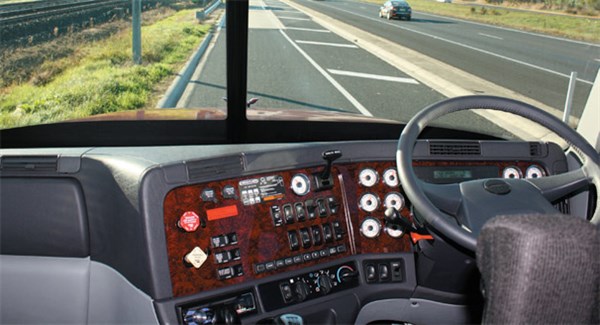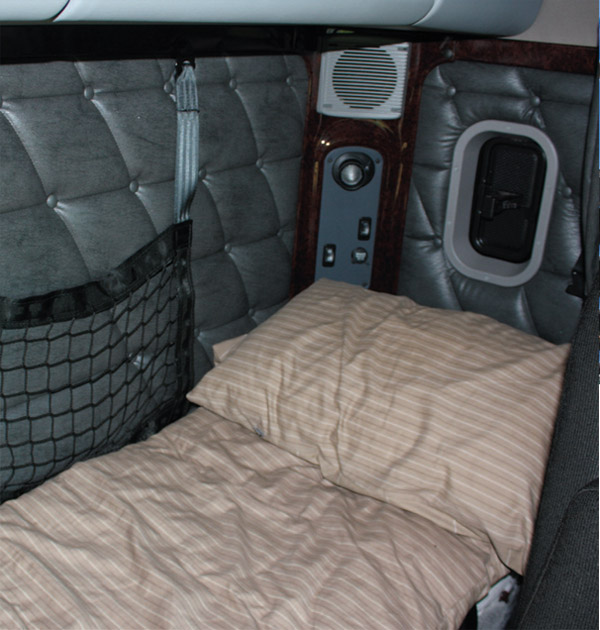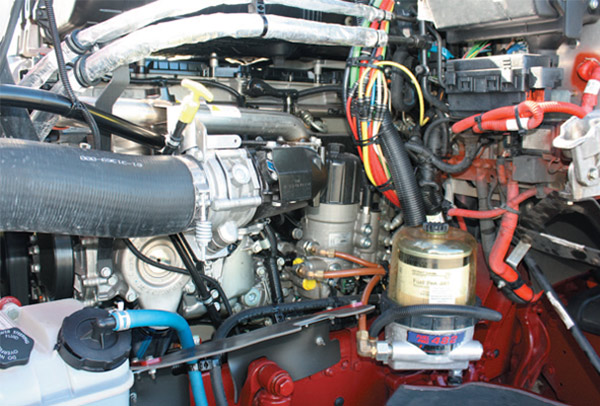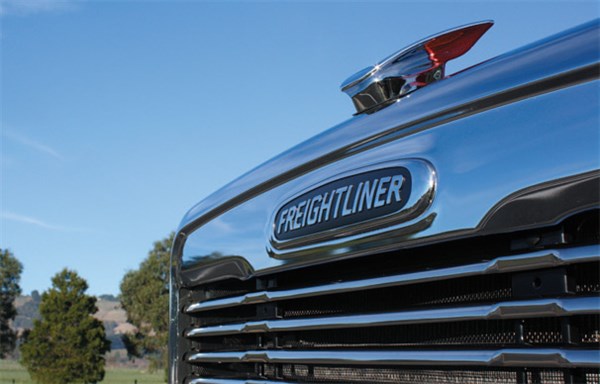Freightliner’s recently released Coronado 114 launches the North American truck maker into the axle forward, short BBC market. Matt Wood spends a day behind the wheel
The newly launched Freightliner Coronado 114 is a short-bonnet, set-forward, steer-axle variant of the big brother 122.
The set-forward steer-axle is to satisfy bridge formula requirements that need to be met when used in high gross weight 19m B-double and tipper-and-dog applications. This enables the whole combination to have as big a footprint as possible, spreading the weight across the whole rig.
As the 114 in the name would suggest, the baby Coronado has a BBC measurement of 114 inches (2,896mm).
The 114 is taking on some pretty stiff competition in the form of Kenworth’s T409 SAR, Mack’s Trident and the Western Star 4800, all of which have been making the most of the tipper and pocket double-tanker market.
While the larger 122 Coronado is seen as the heavy end multi-trailer hauler, Freightliner has still opted to give the little 114 an optional GCM of 106 tonnes; which does give it the option of pulling a two-trailer road train comfortably.
It’s very apparent that the 114 has been built to be a versatile platform capable of plugging through quarries, supplying suburban petrol stations, plying the major freight routes in front of a B-double or even towing a couple of trailers in the back of beyond.
Engine
Underneath the now-stubby nose of the Freightliner, there’s only one engine option, and it’s not a bad one at that — the DD15 Detroit.
The 15-litre exhaust gas recirculation (EGR) engine puts out a respectable power range from 475hp (354kW) and 1,650ft-lb (2,237Nm), through to 560hp (418kW), and 1850ft-lb (2,508Nm) of torque, which puts it in the same ballpark as its Cummins ISX competitor.
Transmission
Transmission-wise there’s the usual 18-speed Eaton manual or UltraShift Plus AMT options, the AMT using the much admired Smart Paddle to control happenings in the box.

Cab and Controls
One of the biggest disappointments about the Coronado is that it has the same family dash and interior layout as virtually all of the Freightliner range.
Apart from the white backing on the gauges, you could be sitting in any Freightliner model, which is a shame considering how different the truck looks from the outside.
Freightliner has copped a fair share of criticism in the past over the quality of its interior plastics. Stories have abounded of slowly descending, or squeaking and rattling interior panels.
Indeed, I recall an incident when I hit the central locking button while I was behind the wheel of a brand new Argosy a few years ago.
With a crack, the plastic grommet from the left hand door lock button flew across the cab and clocked me in the side of the head. But the new dash has been made using a different process and injection moulded.
Freightliner claims that the manufacturing process now provides more consistency and there’s more uniformity in the parts. And they’re right; the dash and the door trims are light years better than anything that Freightliner has had in recent years.
Unfortunately, it’s everything other than the dash that now seems to be the issue. Whereas, in the past, I may not have noticed the squeak in the hood lining, or the rattling cupboards because of the din coming from the dash.
Now, with the dash panels keeping silent, I was able to hear the rattles and squeaks coming from overhead and behind my head.
It’s a shame because it’s little things like this that really let down what is otherwise a great driving and handling truck.
My humble opinion is that the sleeper cab cupboards that Freightliner uses just aren’t suitable for Australian conditions; they need to just ditch the lids and use netting or at least come up with a better cupboard latch.
You may think that I’m being a bit harsh and even that this is just a small issue. And yes, in the scheme of things, all trucks will rattle a bit as they get longer in the tooth.
But, rattles and squeaks and crap stereo speakers will cost transport companies in other unexpected areas, especially in fuel.
Nothing uses fuel like a pissed off driver, you can take the most fuel efficient engine, the most aerodynamic truck in the world and give it to a driver who doesn’t want to be in it and you will be astonished how much fuel an angry, uncomfortable and otherwise unhappy driver can use.

Performance
Importantly, the 114 is also quite a good-looking piece of machinery. Of course, this shouldn’t matter; it’s a truck, a business tool.
But the fact of the matter is that the image of the Freightliner brand has been sorely lacking over the years and the Coronado is the much needed hero truck, the pin-up that the brand has needed for well over a decade.
The big square air grabbing 1,700 square-inch (10,968 square-cm) radiator with its chrome surrounds and grille, and the chromed air intake covers on either side of the engine bonnet all add to the purposeful and unashamedly American look of the 114.
In the past, the styling on some Aussie Freightliner models has seemed almost a bit self-conscious about expressing their inner Yank. Both of the Coronado models and even the new Argosy have a lot more ‘Yee-Haw’ about the way they look.
The apologetic ‘sorry for delivering your groceries’ look seems to be diminishing. But how does all that translate to driving one on the road? Well, I took a 114 and B-double combination for a drive recently.
A nice little test loop that took me from Daimler HQ in Mulgrave down to the La Trobe valley town of Morwell and up over the allegedly haunted hills to the South Gippsland town of Leongatha before heading back to the big smoke.
This route took in metro freeway, rough country blacktop and some pretty steep and winding terrain. And, at the end of the day, as with previous drives of DD15-powered vehicles, I always walk away with a sense that the green coloured Detroit powerplant is a winner for the person behind the wheel.
I climbed aboard the shiny maroon beast and fired up the DD15 for a romp in the hills.
Make no mistake, this is a very easy truck to drive. The short but round edged snout of the 114 gives better-than-expected visibility, the long gear stick stirs the Road Ranger’s cogs with ease.
The way the Detroit puts power to the ground means that on level ground only a couple of gears in bottom box are usually needed to get the combination rolling into high range.
In many ways, it doesn’t feel like a big step from a cabover to the 114 and I didn’t feel as though I was trying to locate myself in my lane too much as I hit the freeway.
If you don’t think this is a big deal, speak to someone who hasn’t driven a cabover for a few months and then put them behind the wheel of one.
You’ll almost guarantee that, for at least the first couple of kilometres, they’ll have the left-hand wheels over the fog line until they acclimatise to their position on the road.
The 114, however, really is a ‘jump in and drive’ proposition.
As indicated earlier, the turbo compound EGR DD15 is a great engine to drive and it chugged along nicely under the bonnet of the Coronado.
It really is just a case of splitting the top couple of gears as you start to climb and the rest can be lugged down changing a whole gear at a time it’ll hang on to 1,150rpm until the cows (of which Gippsland has plenty) come home.
The 114 is noisier on the road than the 122, which makes sense considering that the engine intrudes in the cab that bit more.
There’s also more induction noise apparent, you can hear the powerplant breathing out front, and I could hear the turbocharger rotors whining as they forced the early winter air down the DD15’s throat.
I didn’t find this to be intrusive or an issue but those who may be used to European levels of noise insulation may well find this a bit much. Then again, if plenty of gauges and twin vertical exhaust stacks aren’t your thing then you are probably looking at the wrong brand of truck, or at least a truck from the wrong continent.
Once up into the hills and off the main road, the shiny show pony had to knuckle down and work. The 560hp (418kW) Detroit’s two-speed Horton fan did see some run time as the coolant temperature climbed, though it didn’t seem to suck too much in the way of horsepower out of the driveline.
The DD15 made the most of its long flat torque curve while climbing and the more traditional three-stage Jake brake kept things easily under control on long descents. As with the longer model, the 114 is a great handling truck on uneven and broken black top.
The twin steering boxes mean that there’s very little kickback through the steering wheel and there’s also very little tendency for the vehicle to tram-track, especially on rutted roads that have buckled under the strain of logging trucks and milk tankers.
The twin box set up was needed as the front chassis rails of the 114 have been flared to enable the radiator to be mounted directly to the front of the engine.
This means that when the engine moves on its mounts the radiator moves with it, and the close proximity of the radiator to the fan means that cooling efficiency is maximised.
This particular truck had a 34-inch (86cm) integrated bunk with a mid-roof that was surprisingly roomy.
While the sleeper itself was a bit cosy, the additional height of the roof made the whole interior a lot easier to move around than I’d expected.
While this configuration is ideal for 26m B-double duties, I’m not sure I’d like to be away for weeks at a time in this cab. It seems just right for a working week away, or an ideal changeover bunk. All in all it’s a neat little cab.

Verdict
The Coronado 114 is an easy proposition for a working day, it handles great and it’s an intuitive beast to drive both forwards and backwards.
The DD15 is a great driver’s engine.
Freightliner is slowly getting there when it comes to interior fit and finish.
Unfortunately there’s just still a fair way to go.
I may not have designed it, but then again, nobody asked me to.
Specifications
Make/Model: Freightliner Coronado 114
Cab options: Day cab, 34-inch (86cm) mid-roof sleeper cab, 58-inch (147cm) XT roof sleeper cab
Engine: 15-litre Detroit DD15 with EGR
Power: 475hp (354kW), 1,650ft-lb (2,238Nm) of torque to 560hp (418kW), 1,850ft-lb (2,508Nm) of torque
Transmission: 18-speed Eaton Road Ranger manual or Eaton UltraShift Plus AMT
Steering and suspension: Meritor, FG941 axle (6,624kg) with 16K parabolic taper leaf springs (7,258kg) and TRW THP60 + RCH45 power steering boxes (7,350kg)
Rear axle: Meritor RT46-160GP (maximum)
GCM: Up to 106 tonnes



